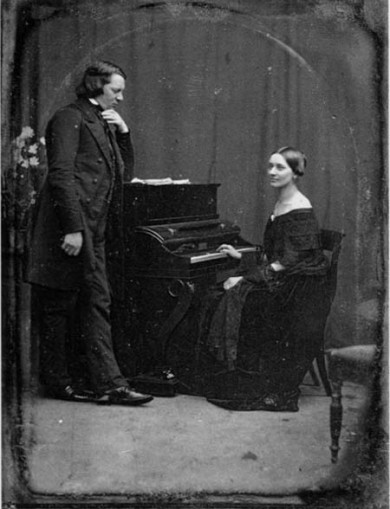New World members pay homage to the Schumanns and their circle
The New World Symphony’s musicians attracted a respectable crowd for their Sunday afternoon chamber concert at New World Center, featuring works by German Romantic composer Robert Schumann and his friends.
While “composer” might suggest a recluse, in the 19th century many composers formed networks with like-minded artists. Schumann, also a noted music critic, promoted Frederic Chopin, Johannes Brahms, violinist Joseph Joachim and others in his New Journal for Music.
Closest to Schumann was his wife Clara, also a composer and among the greatest pianists of her generation. Although dedicated to Joachim, her Three Romances for Violin and Piano, Op. 22 have been arranged for other soloists, including the oboe version performed here.
The Romances are all in the same vein: slowly unfolding lines of interesting but never-jarring chromaticism. Oboist Joseph Peters’ phrasing and Aya Yamamoto’s buttery accompaniment created a relaxed discourse in the lyrical Andante molto and the minor key Allegretto. Despite the piano’s ripples, the fast third romance remained languorous due to slow chord changes and long oboe melodies.
Predictably, Clara Schumann gave the pianist the hardest parts, and Yamamoto’s majestic solo in the central section and rapid staccato variation on the first theme were impressive.
Robert Schumann’s Piano Quintet in E-flat major, Op. 44 was the second half draw. Pianist Nina Zhou gave a dazzling performance of Robert’s massive piano part for Clara. Simplicity and plentiful repetition provided clarity, although more variation on the repeats would have been welcome.
The Allegro brillante’s warm chorales and brief string solos also characterized the remaining movements. Violist Kallie Ciechomski and cellist Kevin Kunkel were superbly matched, sounding like one instrument.
Despite many tricky silences, ensemble coordination marked the funereal march movement with Zhou’s thunderous variation a moment of contrasting passion at the end. Rousing scales in the Scherzo led to impressive passagework from all in a ferocious minor variation. The final Allegro was an ardent team effort, graced by the quintet’s generous support for each soloist.
The real show-stopper of the afternoon was Frederic Chopin’s Cello Sonata in G minor, Op. 65, a masterpiece of Romantic sorrow and longing.
From the opening Allegro moderato, Yamamoto and cellist Aaron Ludwig brought the turbulent, chromatic sequences to vivid life. Despite heavy demands, the performance was multilayered, lamenting, and expressive. Yamamoto’s crisp tone in the Scherzo and Ludwig’s pastoral cello melody in the Largo provided fleeting light. The stormy, exquisitely fused finale underlined the duo’s deep understanding of the work.
Less demanding but no less effective was Franz Liszt’s string quartet version of Angelus! Prayer to the Guardian Angels. The sudden contrasts, from plucked to bowed, soft to loud, and high to low, seemed effortless. Luminous, ethereal support from the ensemble complemented first violinist Derek Powell’s dark colors.
Johannes Brahms’ youthful Scherzo in C minor is from the F-A-E Sonata dedicated to Joachim, and co-composed by Robert Schumann and Albert Dietrich. Jeffrey Dyrda’s firm-edged violin tone defined the muscular theme, but Zhou’s accompaniment at times overpowered him. Ominously repeated notes from Zhou during the sweetly searching trio ultimately built into a fiery finish.
Posted in Performances
Leave a Comment
Mon Mar 17, 2014
at 11:31 am
No Comments
